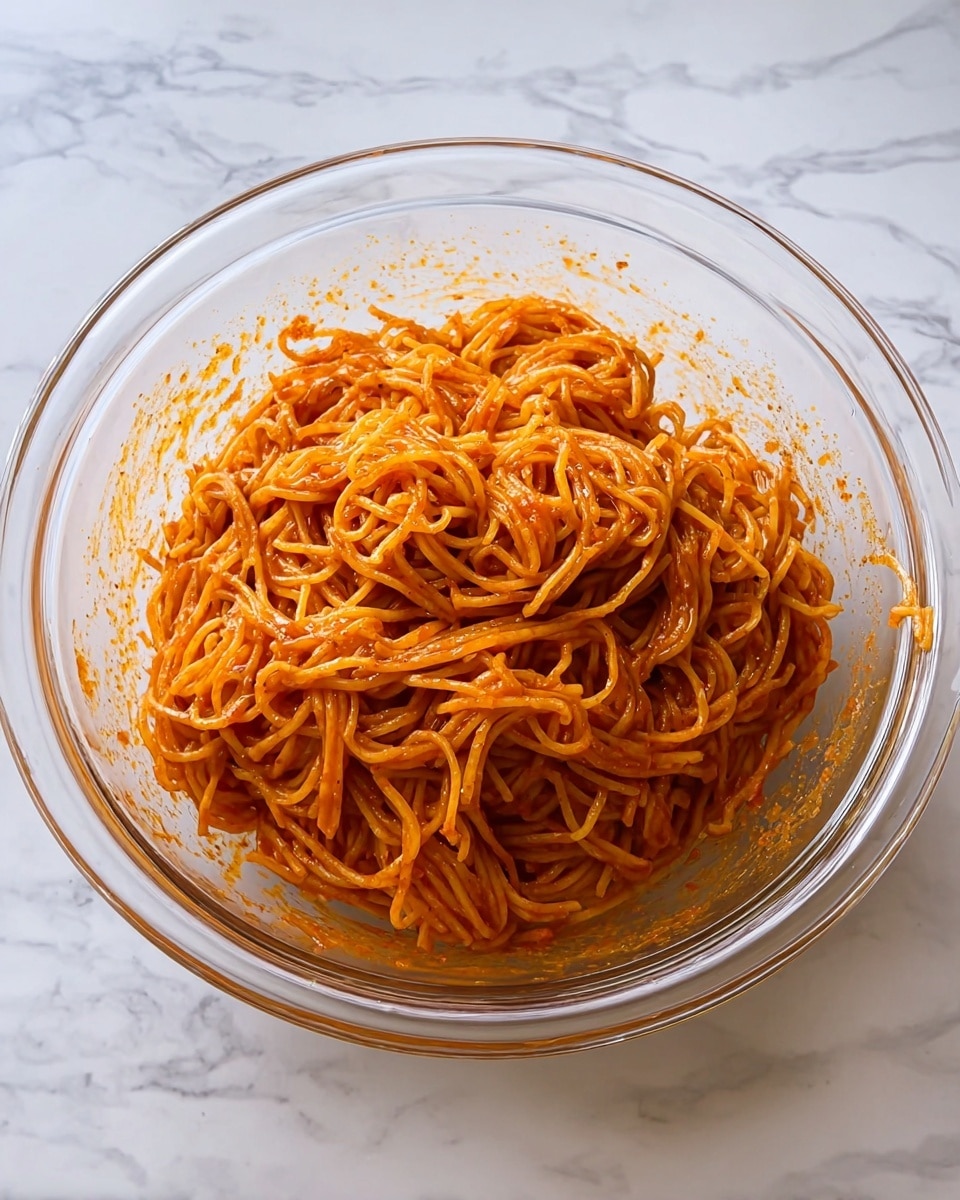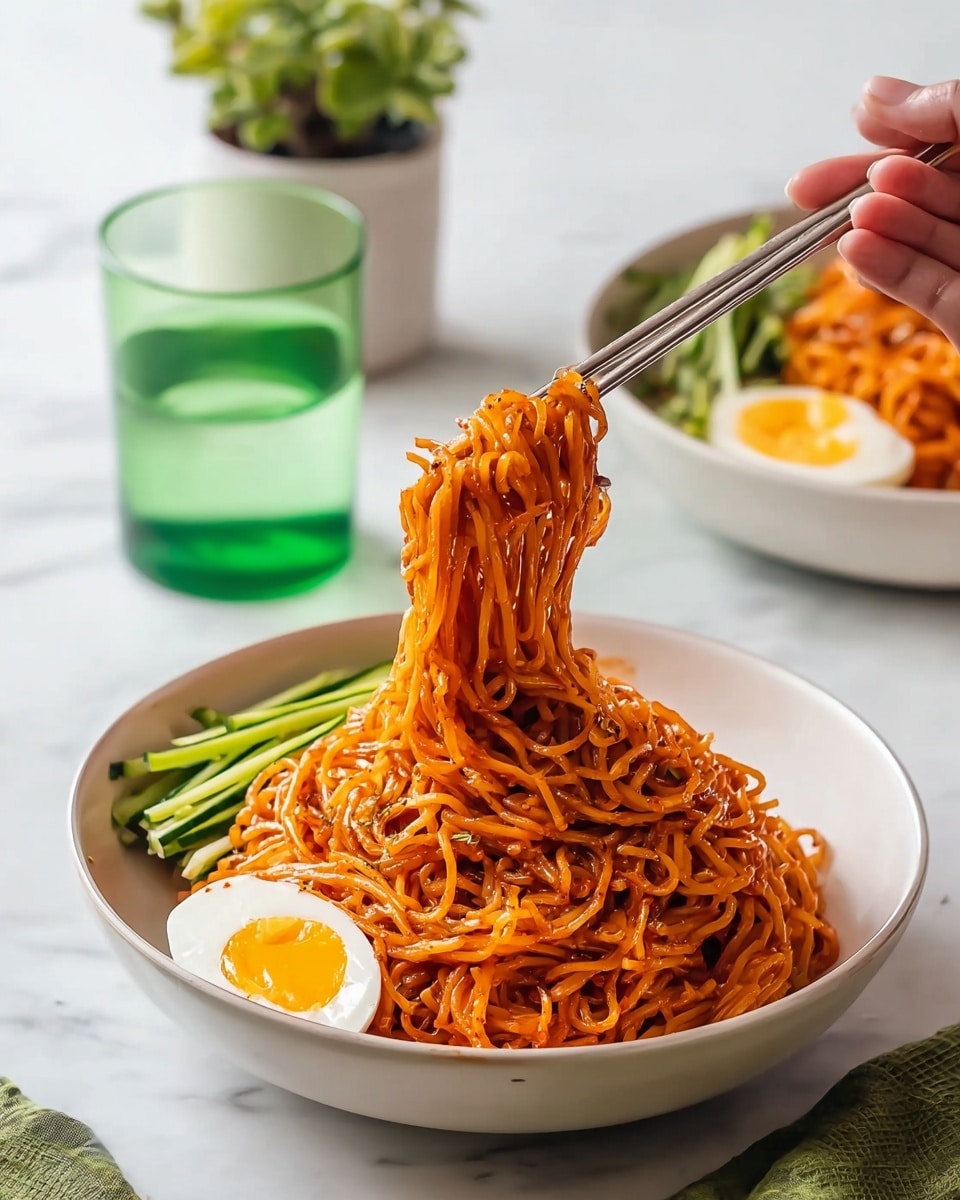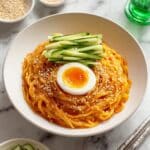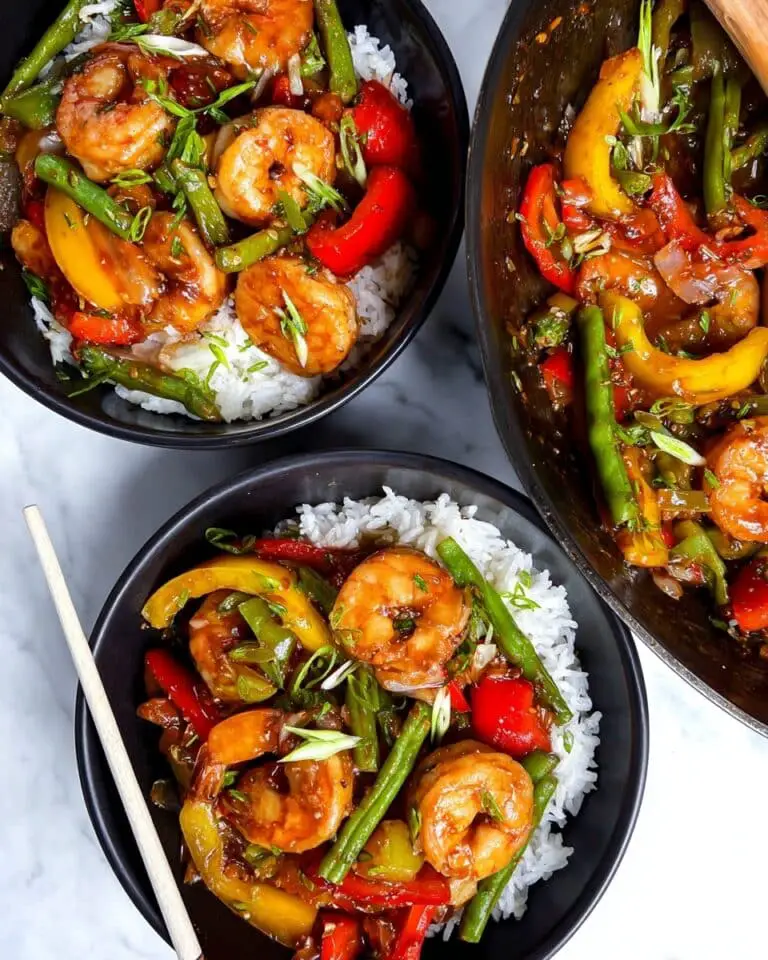If you’re craving something refreshingly spicy with a truly Korean twist, then this Bibim Guksu (Korean Spicy Cold Noodles) Recipe is just what you need. This vibrant dish combines silky thin wheat noodles chilled to perfection and tossed in a bold, balanced sauce packed with gochujang and garlic, delivering a bright, tangy, and delightfully spicy flavor that wakes up your palate. It’s a perfect meal for warm days or anytime you want a satisfying dish that feels light but full of character. Once you try this Bibim Guksu, it’ll become your go-to recipe for quick lunches or dinners!
Ingredients You’ll Need

Getting the flavors right in Bibim Guksu is all about using simple but essential ingredients that each bring something special to the dish. These ingredients not only build the signature spicy and sweet profile but also create a mix of textures and colors that make every bite exciting.
- 8 oz somyeon noodles: Thin wheat noodles that cook up soft and perfect for soaking up the luscious sauce.
- 3 tablespoons gochujang: Korean fermented chili paste that adds smoky heat and depth of flavor.
- 2 teaspoons gochugaru: Korean chili flakes boosting the spiciness with a slightly smoky kick.
- 2 tablespoons soy sauce: Adds a savory, salty umami base that balances the spice.
- 2 tablespoons sesame oil: Gives a rich, nutty aroma that makes the dish irresistible.
- 2 tablespoons rice vinegar: Brings a zesty tang to brighten the bold flavors.
- 3 cloves garlic, minced: Fresh garlic punch to enhance the sauce’s complexity.
- 2 ½ tablespoons honey: A touch of sweetness to mellow the heat and tie everything together.
- 1 tablespoon toasted sesame seeds, crushed: Adds crunch and a fragrant finish.
- 1 cucumber, thinly sliced: Cool and crisp contrast that refreshes every bite.
- 1 soft-boiled egg: Creamy topping that brings a silky richness to the dish.
- Kimchi: Traditional fermented side to add a punch of fermented tang and texture.
How to Make Bibim Guksu (Korean Spicy Cold Noodles) Recipe
Step 1: Prepare the Sauce
Start by combining the heart of this Bibim Guksu recipe—the sauce. In a mixing bowl, whisk together the gochujang, gochugaru, soy sauce, sesame oil, rice vinegar, minced garlic, honey, and toasted sesame seeds. This sauce is where all the magic happens, balancing sweet, sour, spicy, and nutty notes. Set the sauce aside so the flavors blend while you move on to cooking the noodles.
Step 2: Cook the Noodles
Bring a medium pot of water to a boil and cook the somyeon noodles according to the package instructions, usually around 3 to 4 minutes until tender but still with a slight bite. Then, immediately drain and plunge the noodles into a bowl of ice-cold water to stop them from cooking further and to give them that refreshing coolness essential to this dish’s appeal. Drain well once chilled.
Step 3: Toss the Noodles with Sauce
Place the drained cold noodles in a large bowl and pour your prepared sauce evenly over them. Toss everything together with tongs or chopsticks so each strand is thoroughly coated with that glorious spicy sauce. This step is where the noodles transform from plain to spectacular, marrying flavor and texture beautifully.
Step 4: Garnish and Serve
To finish, top your Bibim Guksu with the refreshing cucumber slices, a perfectly soft-boiled egg, a sprinkle of additional toasted sesame seeds, and a side or topping of kimchi for that traditional Korean tang and crunch. Now it’s time to dig in and enjoy this fresh, spicy noodle experience!
How to Serve Bibim Guksu (Korean Spicy Cold Noodles) Recipe

Garnishes
Garnishes are not just for looks; they add balance and extra texture. The thin cucumber slices add a crisp, cooling bite that contrasts delightfully with the spicy sauce. The soft-boiled egg’s creamy yolk introduces softness and richness, complementing the noodles perfectly. And toasted sesame seeds add a tiny crunch and nutty aroma to every forkful.
Side Dishes
To make your Bibim Guksu meal complete, serve it alongside classic Korean sides like kimchi, which delivers an extra layer of tanginess and spice. Pickled radishes or a light seaweed salad also pair beautifully, enhancing the refreshingly spicy vibe of the noodles without overwhelming them.
Creative Ways to Present
For a fun twist, try serving your Bibim Guksu in individual bowls garnished artistically with julienned veggies like carrots or radishes, edible flowers, or even some fresh herbs like mint or cilantro. You can also add crushed peanuts or toasted nori strips to give the dish some new textures and flavors.
Make Ahead and Storage
Storing Leftovers
If you find yourself with leftovers, store the dressed noodles and garnishes separately in airtight containers in the refrigerator to prevent sogginess. The noodles will keep well for up to one day when kept cold and separated from the sauce until ready to serve again.
Freezing
It’s best not to freeze Bibim Guksu because the texture of the cold noodles and fresh garnishes can change drastically. The sauce itself can be stored in the freezer, but fresh noodles and cucumber won’t thaw well and will lose their signature texture.
Reheating
Reheating Bibim Guksu is not recommended since it is intended to be enjoyed cold. If you need to refresh leftovers, let the noodles come to room temperature and toss again with a bit of fresh sesame oil or sauce to regain some vibrancy before eating.
FAQs
Can I use other noodles for Bibim Guksu?
Absolutely! While somyeon noodles are traditional, you can substitute with thin spaghetti or angel hair pasta in a pinch. Just make sure to rinse them well in cold water to chill and prevent sticking.
How spicy is this Bibim Guksu (Korean Spicy Cold Noodles) Recipe?
The heat level can be adjusted easily by tweaking the amount of gochujang and gochugaru you use. The recipe strikes a nice balance of spicy and sweet, but feel free to add more chili flakes if you like a stronger kick!
Can I make Bibim Guksu vegan?
Yes! Simply omit the soft-boiled egg and make sure your gochujang does not contain any animal products. The sauce and noodles themselves are vegan-friendly.
Is Bibim Guksu served cold all year round?
Traditionally, Bibim Guksu is enjoyed cold, especially in warmer months for its refreshing and cooling qualities, but you can enjoy it any time you want a light, spicy meal.
What can I add to make Bibim Guksu more filling?
Adding protein like grilled chicken, tofu, or even some thinly sliced beef can make this dish heartier while keeping the flavors vibrant and fresh.
Final Thoughts
If you’re looking for a quick, vibrant meal that brings the exciting flavors of Korea right to your kitchen, I wholeheartedly encourage you to try this Bibim Guksu (Korean Spicy Cold Noodles) Recipe. It’s an absolute crowd-pleaser, bursting with fresh, spicy, and tangy layers that will keep you coming back for more. Plus, its simplicity and speedy preparation make it a total winner any day of the week!
Print
Bibim Guksu (Korean Spicy Cold Noodles) Recipe
- Total Time: 10 minutes
- Yield: 2 servings
Description
Bibim Guksu is a refreshing Korean spicy cold noodle dish perfect for quick lunches or dinners. Featuring thin wheat noodles tossed in a vibrant gochujang-based sauce with a perfect balance of heat, sweetness, and tang, this dish is garnished with crunchy cucumber slices, a soft-boiled egg, kimchi, and toasted sesame seeds for a delightful textural contrast.
Ingredients
Noodles
- 8 oz somyeon noodles (thin wheat noodles)
Sauce
- 3 tablespoons gochujang (Korean red chili paste)
- 2 teaspoons gochugaru (Korean chili flakes)
- 2 tablespoons soy sauce
- 2 tablespoons sesame oil
- 2 tablespoons rice vinegar
- 3 cloves garlic, minced
- 2 ½ tablespoons honey
- 1 tablespoon toasted sesame seeds, crushed
Garnish
- 1 cucumber, thinly sliced
- 1 soft-boiled egg
- Toasted sesame seeds, for sprinkling
- Kimchi, for serving
Instructions
- Make the sauce: In a mixing bowl, combine the gochujang, gochugaru, soy sauce, sesame oil, rice vinegar, minced garlic, honey, and crushed toasted sesame seeds. Stir thoroughly until the sauce is smooth and well combined. Set aside to allow flavors to meld.
- Cook the noodles: Bring a medium pot of water to a rolling boil. Add the somyeon noodles and cook according to the package instructions, usually about 3-4 minutes, until just tender. Drain and immediately rinse the noodles under ice-cold water to stop the cooking process and chill them. Drain well again to remove excess water.
- Combine: Transfer the chilled noodles to the bowl with the prepared sauce. Toss gently but thoroughly to ensure every strand is evenly coated with the spicy, tangy sauce.
- Serve: Plate the noodles and garnish with thinly sliced cucumber, a soft-boiled egg halved or whole, kimchi on the side, and a sprinkle of toasted sesame seeds. Enjoy immediately for the best texture and flavor.
Notes
- For extra protein, add shredded cooked chicken or tofu alongside the noodles.
- Adjust the honey and vinegar amounts to your preferred balance of sweetness and acidity.
- Make sure to rinse the noodles in ice water to achieve the signature chewy and cold texture.
- This dish is best served immediately after mixing to prevent the noodles from absorbing too much sauce and becoming soggy.
- Garnishes can be varied with other fresh vegetables like julienned carrots or radishes.
- Prep Time: 5 minutes
- Cook Time: 5 minutes
- Category: Dinner, Lunch
- Method: Stovetop
- Cuisine: Korean







